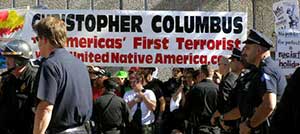In this day and age, Christopher Columbus is known by most Americans as the brave and tireless explorer who made the treacherous journey across the Atlantic to discover the New World. It’s a common perception, seeing as how the earliest mentions of the explorer originate in elementary school most often, and paint him as a heroic figure that civilized the Americas. Well, as it would turn out, not only is this view point incredibly wrong, it’s downright insulting to many Native Americans, some of which have actually gone as far as to equate Columbus with Hitler. The issue that is taken against the typically renown explorer is that the Native American people feel that the celebration of Columbus day is in a way a celebration of the mass genocide against their people that the European colonist brought about. Now obviously, this was not the intention of anyone planning the parades or celebrations. However, in the movie Unsettling Columbus Day it is clearly shown that the intentions of one group may come off as offensive to another. Particularly, the apparent embracement of Columbus as a cultural figure in the Italian community upsets the Native Americans, for to them the treatment of Columbus and the explorers that came with him was nothing to be celebrated. For this reason, the Native Americans gather every year to protest the Columbus Day parade in Columbus, Colorado where it was first established.
The Native American community is hurt that almost no regard is given to their sentiments on such a day that has a very significant part of their own history behind it. A fair compromise perhaps would be to include the Native peoples in deciding what should be done concerning the day, and involve them more proactively in the archaeological anaylisis of the history of Columbus. This process would take the form of indigenous archaeology. Indigenous archaeology is the form of archaeology in which indigenous people are involved in the excavation and care of the culture and artifacts of their ancestors. By neglecting the Native people’s concerns and their outreach to assist in more fully developing a coherent and correct history of Christopher Columbus for all, one big wave of ignorance is formed in which protesters are seemingly angry with no direction, as seen in the documentary, and parade goers are insulted anyone would ruin their fun. Through indigenous archaeology, the Native Americans can settle the offensive material away from the festive, and establish a more fairly balanced telling of Columbus for even textbooks.
Sources:
http://www.transformcolumbusday.org/
http://www.history.com/topics/columbus-day
http://occupydenver.org/wp-content/uploads/2012/09/20071006__20071007_C1_CD07COLUMBUSp1.jpg





